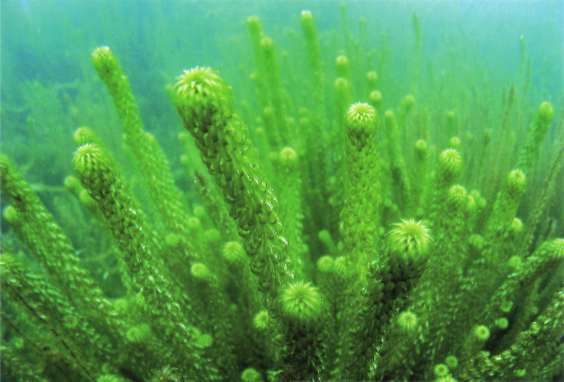Lagarosiphon major was first recorded in Britain in a chalk pit in 1944.
It has since spread to many locations and has displaced both
Elodea canadensis and Elodea nuttallii by virtue of its superior
photosynthetic capacity in alkaline water. There are nine species of
Lagarosiphon, all from Africa. L.major is native to Southern Africa,
where it is also a nuisance weed species. It is sold by garden centres and
aquarists as an oxygenating plant, often mis-labelled as Elodea crispa
(no such plant!). All plants in the UK are thought to be female. The
flowers are borne singly in the axils of leaves on a long stem (called
a hypanthia) and they float on the surface of the water. The flower
has a sail composed of 3 staminodes (petals) and they blow freely across
the surface of the water. Pollination is achieved when a male and female
flower encounter each other on the surface. Because there are no male
plants in the UK, all reproduction is by fragmentation or vegetative
reproduction. Small fragments can become rooted, and in many sites
lateral branches become detached and float to increase dispersal within
a lake or pond. There is no evidence that it is carried form one site to
another by birds, because it is a large plant, so new observations are
likely to have been due to deliberate introduction by human activity.
Lagarosiphon will grow down to 3 m in still water. It does not grow
in fast flowing water, although it will grow in canals, drainage ditches
and slow-flowing rivers. The leaves measure between 6 and 300 mm in length
(depending on nutrient status) and are between 1 and 3 mm wide. They are
strongly recurved, that is they roll back and point at the stem below.
The leaves are borne in a whorl or spiral of 3s around the stem. The
leaves rapidly become encrusted with calcium carbonate marl on the upper
surface, a consequence of the way in which carbon is taken up by the plant.
Photosynthesis by this plant can take the pH up to values over 10, and
may reach 10.4 (the limit ofbicarbonate uptake) in small ponds. This
feature is the key to its success in dominating mixed plant communities
as few submerged macrophytes can photosynthesise effectively at such
high pH. Prolonged periods of high pH will lead to the loss of less
competitive species.
Mechanical Control
This plant tends to survive over-winter in southern areas of Britain,
and therefore mechanical control can be undertaken early in the season.
Further north, the plant mass collapses, but never dies down completely,
meaning that early season cutting should be deeper than normal, or should
be delayed until the plant has started to grow in late April. Care should
be taken to remove as much cut material as possible because of the problem
of vegetative reproduction from fragments. Cutting tends to dislodge the
brittle side branches which float away and root elsewhere, increasing
the problem or at least spreading to uninfested sites.
Chemical Control
Lagarosiphon is susceptible to herbicides containing terbutryn, dichlobenil
or diquat. The preferred method of control is application of dichlobenil
in March or early April. Application of terbutryn as Clarosan will kill
most submerged vegetation and so should only be used where Lagarosiphon
is the dominant species. Clarosan should be applied in April.
Diquat as Reglone or Midstream can be used quite successfully until
early June, or until the leaves become encrusted with marl as described
above. The marl effectively restricts uptake of the herbicide. Control
after late June with herbicides is usually not successful, although
Clarosan can be used when there are no fish present, as the sudden
decline in photosynthesis causes a severe drop in oxygen concentration
which will killfish. This does not occur when Clarosan is applied in
spring.
Biological Control
Grass carp will eat Lagarosiphon if they have no other choice, but it is
not one of their preferred foods. There are no known classical biological
control agents appropriate for release in the UK.
Environmental Control
Increasing shade will reduce the growth of this species, although because
it tends to occupy such large areas, the application of shade will often
be inappropriate. Excavation to depths of over 4 m will also prevent growth
but again this is impractical. Increasing flow may reduce the growth of
the species in situ, but is likely to spread the plant to other previously
unaffected areas.
Best Option
Treat with dichlobenil in April
